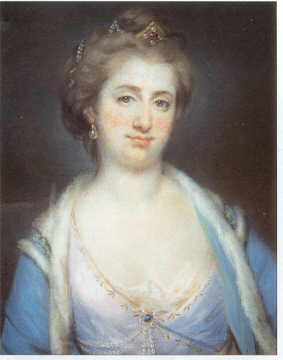Elizabeth Pierrepont, Duchess of Kingston-upon-Hull facts for kids
Quick facts for kids Elizabeth Pierrepont |
|
|---|---|
 |
|
|
|
|
| Spouse(s) | Augustus Hervey, 3rd Earl of Bristol Evelyn Pierrepont, 2nd Duke of Kingston-upon-Hull |
| Father | Colonel Thomas Chudleigh |
| Mother | Henrietta Clifford |
| Born | 8 March 1721 London, England |
| Died | 26 August 1788 Paris, France |
| Occupation | Maid of Honour to Princess Augusta of Saxe-Gotha |
Elizabeth Pierrepont (born Elizabeth Chudleigh), also known as the Duchess of Kingston, was a fascinating English noblewoman. She lived from 1721 to 1788. People in her time knew her for her exciting and sometimes complicated life.
Elizabeth started her career at the royal court. In 1743, she became a Maid of Honour to Princess Augusta of Saxe-Gotha, who was the Princess of Wales. This was an important job, helping the Princess with her daily life. Elizabeth became famous for a very unusual legal case about her marriages.
Contents
Elizabeth's Early Life and First Marriage
Elizabeth Chudleigh was born in London, England, on March 8, 1721. Her father, Colonel Thomas Chudleigh, was an officer at the Royal Hospital, Chelsea. Sadly, he passed away when Elizabeth was still very young.
Elizabeth was a popular young woman and had many admirers. One of them was Augustus Hervey, a naval officer. On August 4, 1744, Elizabeth and Augustus secretly got married. The wedding happened at night at a private country house called Lainston House, near Winchester, Hampshire. They kept their marriage a secret because they both needed to keep their jobs and financial support. Elizabeth needed to stay a Maid of Honour at court, and Augustus needed to stay in the navy.
Their marriage was not a happy one, and they did not live together for many years. Because their marriage was secret, it seemed like they didn't need to officially end it.
A New Life and Legal Challenges
Elizabeth became a well-known figure in British society. In 1765, she even met Frederick the Great, a famous king, in Berlin. Later, she became close to Evelyn Pierrepont, 2nd Duke of Kingston-upon-Hull.
Elizabeth wanted to make sure her first marriage to Augustus Hervey was officially over. She started a legal case to prove that she was not married to him. In February 1769, a court ruled that she was single and free to marry. Just a month later, she married the Duke of Kingston and became Elizabeth Pierrepont, Duchess of Kingston-upon-Hull. The Duke built a beautiful home for her in London, called Kingston House.
The Duke of Kingston passed away four years later. He left all his property to Elizabeth, but only if she remained a widow. After his death, Elizabeth traveled a lot. She visited Rome and was even welcomed by Pope Clement XIV with the respect given to a duchess.
The Famous Court Case
In 1775, Augustus Hervey's brother died, and Augustus became the Earl of Bristol. This meant that if Elizabeth's first marriage was still valid, she would technically be the Countess of Bristol.
However, a nephew of her second husband, Evelyn Medows, challenged the Duke of Kingston's will. He claimed that Elizabeth's first marriage was still valid, which meant her marriage to the Duke of Kingston was not legal. This led to a very public and famous court case.
In 1776, Elizabeth was put on trial in Westminster Hall. Many important people, called peers, heard her case. They decided that her first marriage was indeed valid. This meant her second marriage was not legally recognized. After the trial, Elizabeth quickly left England to avoid more legal problems.
Later Years and Influence
Elizabeth lived in different places after the trial, including Calais in France and Russia. She was welcomed at the Russian court and even bought several properties in Estonia, which she named "Chudleigh." She wanted to create a model English estate there.
Elizabeth continued to call herself the Duchess of Kingston. She lived in Paris, Rome, and other places. She passed away on August 26, 1788, at her estate near Paris, at the age of 67. Even though she called herself a duchess, legally, she was still considered the Countess of Bristol.
Elizabeth's life was so interesting that it inspired writers and artists. A comedian named Samuel Foote wrote a play about her. She is also thought to have inspired a character in famous novels by William Makepeace Thackeray, like The History of Henry Esmond. Her story shows how complex life could be for women in high society during her time.
Images for kids


